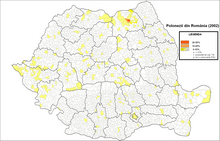Poles in Romania
 Poles in Romania (2002 census) | |
| Total population | |
|---|---|
| 2,137 (2021) | |
| Regions with significant populations | |
| Suceava County | |
| Languages | |
| Polish·Romanian | |
| Religion | |
| MainlyRoman Catholicism,but alsoGreek CatholicandOrthodox | |
| Related ethnic groups | |
| Polish diaspora |
According to the2021 Romanian census,2,137Poleslive in Romania,[1]mainly in the villages ofSuceava County(Polish:Suczawa). There are three exclusively Polish villages, as follows:Nowy Sołoniec(Solonețu Nou),Plesza(Pleșa), andPojana Mikuli(Poiana Micului), as well a significant Polish presence inKaczyca(Cacica) andPaltynosa(Păltinoasa). There is also a relatively sizable number of ethnic Poles living in the county seat,Suceava(Polish:Suczawa).
Poles in Romania form an officially recognisednational minority,having one seat in theChamber of Deputies(currently held by theUnion of Poles of Romania) and access to Polish elementary schools and cultural centres (known as "Polish Houses" or "Dom Polski" in Polish).[2]
History
[edit]| Year | Pop. | ±% |
|---|---|---|
| 1930 | 48,310 | — |
| 1948 | 6,753 | −86.0% |
| 1956 | 7,627 | +12.9% |
| 1966 | 5,860 | −23.2% |
| 1977 | 4,641 | −20.8% |
| 1992 | 4,232 | −8.8% |
| 2002 | 3,559 | −15.9% |
| 2011 | 2,543 | −28.5% |
| 2022 | TBD | — |
| Official census data | ||


The first Poles settled inMoldaviain the times ofCasimir III(specifically during theLate Middle Ages). Most of the Poles immigrating after 1774 were looking for work. So it was that Polish miners fromBochniaandWieliczkawere brought to salt mines in Cacica.
Another wave of Polish immigration arrived inBukovinain the early 19th century, when the region was acrownlandof theAustro-Hungarian Empire,as was a significant portion of present-day southern Poland (see:Kingdom of Galicia and Lodomeria).[citation needed]
Around 1803, Polish highlanders fromČadca(Polish:Czaca, Czadca) settled inTreblecz(Tereblecea,now inChernivtsi Raion,Chernivtsi Oblast,Ukraine) bySiret,inStara Huta Krasnaand inKaliczankaand again in 1814 to 1819, this time settling inHliboka(Adâncata) andTereszna.Nowy Sołoniec was settled in 1834, Plesza in 1835, and Pojana Mikuli in 1842.
At that time, it must be mentioned that Bukovina was a very attractive region of theAustrian Empireto live in thanks to Austria's policy not to conscript recruits into its army from there (service in the Austrian army at that time was for a 14-year term).
Furthermore, Bukovina was free fromserfdom,primarily attracting immigrants ofGerman(who later formed the basis of theBukovina Germancommunity of the region),Jewish,and alsoCzecho-Slovakorigin but also Polish ethnicity and evenRussianandItalian.[citation needed]
There were probably other waves of migration from Poland after theNovemberandKraków Uprisings,but most Poles were from peasant families relocated there by the Empire's authorities after they participated in theJakub Szelainsurrection.[citation needed]
DuringWorld War I,Lucjan Skupiewski, Polish physician born inWarsaw,was the organizer and manager of all hospitals for the wounded in the Bucharest area.[3]After the war, he stayed in Romania, and was the deputy deputy mayor of Bucharest and senator for the Polish minority.[3]
Following the restoration of independent Poland, since 1919, many Poles leftBukovinafor Poland.[4]Four Polish newspapers were issued in Romania in the interbellum (Gazeta Polska,Głos Ludu,Głos Prawdy,Kurier Polski w Rumunii).[5]
AfterWorld War II,many Poles from the sizeable Polish communities in Bukovina andLupeniwere repatriated to Poland.[6][7]
Communes with the highest Polish population percentage
[edit]
- Suceava County
- Cacica— 20.04%
- Mănăstirea Humorului— 19.3%
- Mușenița— 4.06%
- Moara— 3.23%
- Păltinoasa— 1.14%
Notable Polish Romanians
[edit]
- Ciprian Porumbescu,composer
- Marian Kielec,footballer
- Corneliu Zelea Codreanu,politician, founder of theIron Guard
- Ioan Gyuri Pascu(partly Polish), musician, actor, and comedian
- Octavian Smigelschi(partly Polish), painter
- Stefan Norris(born in Poland; subsequently settled in Romania), art director
- Mărgărita Miller-Verghy,author, journalist, critic, and translator
- Wojciech Weiss,painter
- Leonard Mociulschi,major general
- Henri Cihoski,lieutenant-general
- Robert Sadowski,international footballer
- Michał Belina Czechowski,Seventh-Day Adventist preacher
- Ghervazen Longher,politician
- Adolf Zytogorski(born in Romania; moved to Poland then England), chess master and translator
- Tytus Czerkawski,politician
- Izydor Kopernicki,physician
- Iosif Malinovski,Roman Catholic vicar and publisher
- Gustaw Otręba,physician
- Witold Rola Piekarski,cartoonist and academic
- Feliks Wierciński,Roman Catholic priest and schoolteacher
Gallery
[edit]-
The Polish House in Suceava (Polish:Dom Polski w Suczawie), built at the round of the 20th century (more specifically between 1903 and 1907)
-
Polish newspaper in Romania
-
The salt mine in Cacica (Polish:Kaczyka), Suceava county, southern Bukovina
-
Roman Catholic basilica in Cacica
-
View from the village of Pleșa (Polish:Plesza)
-
View from the village of Pleșa (Polish:Plesza)
-
View from Solonețu Nou (Polish:Nowy Sołoniec)
-
Natural landscape from the village of Pleșa (Polish:Plesza)
-
Natural landscape from the village of Pleșa (Polish:Plesza)
See also
[edit]- Polish–Romanian alliance
- Romanian Bridgehead
- Poland–Romania relations
- Polonia Cernăuți
- Poles in Bulgaria
- Poles in Moldova
- Poles in Hungary
- Poles in Ukraine
- Polish diaspora
References
[edit]- ^"Population and housing census, 2021 - provisional results | National Institute of Statistics".insse.ro.Retrieved2023-08-13.
- ^Redacția Orașul Suceava."Uniunea Polonezilor din România".Orașul Suceava(in Romanian).Retrieved20 September2022.
- ^abJudycki, Zbigniew Andrzej (2020).Lekarze polskiego pochodzenia w świecie(in Polish). Kielce. p. 95.ISBN978-83-936896-5-1.
{{cite book}}:CS1 maint: location missing publisher (link) - ^Paczkowski, Andrzej (1977).Prasa polonijna w latach 1870–1939. Zarys problematyki(in Polish). Warszawa:Biblioteka Narodowa.p. 118.
- ^Paczkowski, p. 119
- ^Krasowska, Helena (2017).Górale polscy na Bukowinie karpackiej(in Polish). Warszawa: Slawistyczny Ośrodek Wydawniczy, Instytut SlawistykiPolskiej Akademii Nauk.p. 77.
- ^Nowak, Krzysztof (2018). "Reemigracja polskich górników z Rumunii na Górny Śląsk po II wojnie światowej".Śląski Kwartalnik Historyczny Sobótka.LXXIII(4): 77.ISSN0037-7511.
External links
[edit]- Map of Polish villages in Romania
- (in Polish)Polonia w Rumunii
- (in Polish and Romanian)Polscy uchodźcy w Rumunii 1939–1947. Dokumenty z Narodowych Archiwów Rumunii / Refugiații polonezi în România 1939–1947. Documente din Arhivele Naționale ale României, t. 1, cz. 1 i 2[permanent dead link]*The Polish organization in Romania
- Polish minority in Cacica - Romania (archive)













